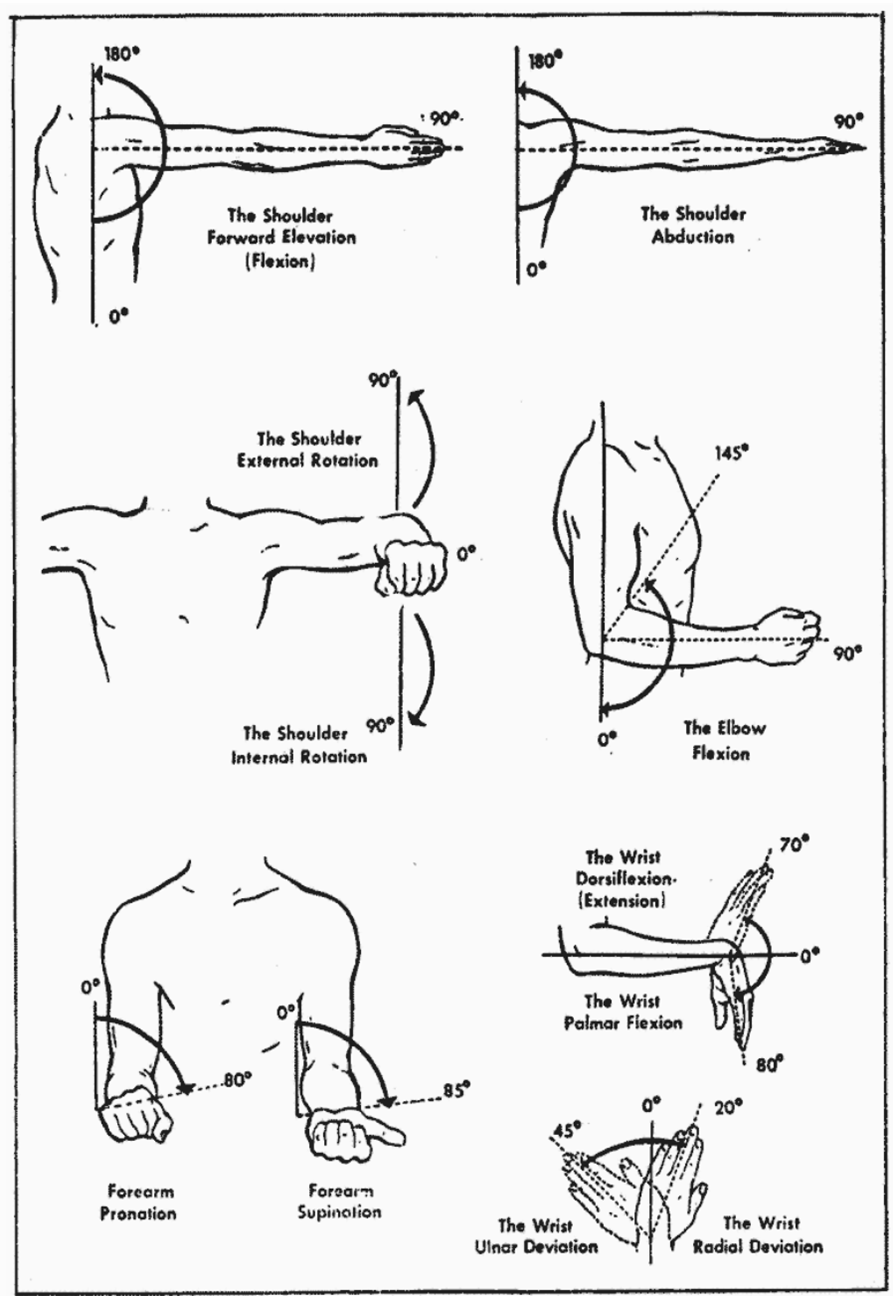Looking for Expert-Level VA Claim Answers?📱Call Us Now! 737-295-2226
Filing a VA disability claim for shoulder pain is an important first step toward securing the benefits you’ve rightfully earned through your service to our country.
The next critical step is attending the in-person Compensation and Pension (C&P) exam, where you’ll undergo a Range of Motion (ROM) test designed to evaluate the severity of your shoulder condition.
An accurate and comprehensive VA shoulder ROM test is critical in determining your final VA disability rating.
Knowing what to expect and how to prepare for this exam can make a substantial difference in the success of your claim.
Table of Contents
Summary of Key Points
- Importance of the C&P Exam: The in-person Compensation and Pension (C&P) exam, including the Shoulder Range of Motion (ROM) test, is critical for determining your VA disability rating and securing the benefits you’ve earned.
- Shoulder ROM Test Overview: The VA Shoulder ROM test measures how far and in what directions you can move your shoulder joint, helping to assess the severity of your condition and any functional impairments.
- Impact on Disability Rating: The results of the ROM test directly influence your VA disability rating, with limited range of motion due to pain or stiffness potentially leading to a higher rating and greater compensation.
- Common Shoulder Conditions: Various shoulder conditions, such as rotator cuff tears, frozen shoulder, and arthritis, can significantly reduce your range of motion and impact your VA disability rating, making it essential to inform the C&P examiner of these issues.
What is the VA Shoulder Range of Motion Test?
The VA Shoulder Range of Motion (ROM) test is conducted during your in-person C&P exam to assess the severity of your shoulder condition.
This test measures how far and in what directions you can move your shoulder joint.
Typically, a goniometer, a specialized tool for measuring joint angles in degrees, is used to ensure precise results.
During the test, the examiner will guide you through a series of shoulder movements to evaluate your range of motion.
The purpose is to compare your shoulder’s mobility against standard ranges and to identify any limitations due to pain, stiffness, or other impairments.
Why is the VA Shoulder ROM Test Important?
The VA uses the results of the shoulder ROM test to gauge the functional impairment caused by your condition.
Since your VA disability rating is based on the severity of your symptoms and how they affect your daily life, demonstrating limitations in shoulder movement can significantly impact your final rating.
For example, limited range of motion due to pain or stiffness could lead to a higher disability rating, which translates into greater compensation.
On the other hand, if your range of motion is near normal, the VA may assign a lower rating, even if you experience pain or discomfort.
How is Shoulder Range of Motion Measured by the VA?

The VA measures shoulder range of motion in several key directions, each corresponding to specific movements:
- Flexion (0 to 180 degrees): This movement involves raising your arm in front of you, starting from your side and lifting it until it points straight up overhead.
- Extension (0 to 50 degrees): Extension is the movement of your arm backward from a resting position by your side, extending it behind your torso.
- Abduction (0 to 180 degrees): This involves raising your arm sideways away from your body until it points straight up overhead.
- Internal Rotation (0 to 90 degrees): With your elbow bent at a 90-degree angle, internal rotation involves rotating your arm inward toward your body.
- External Rotation (0 to 90 degrees): This is the opposite of internal rotation, where you rotate your arm outward away from your body with your elbow bent.
What to Expect During the VA Shoulder ROM Test
During your C&P exam for the shoulder, the examiner will ask you to perform these movements while they use the goniometer to measure the angle of each movement.
They will note the degree to which you can move your shoulder without pain and the point at which pain begins.
The examiner may also assess your ability to perform these movements repeatedly to determine if there is any loss of motion or increase in pain with repetitive use.
Pro Tip: If a movement causes discomfort or pain, stop immediately and let the C&P examiner know. If you’re unable to perform a movement, don’t attempt to force it. Your health and well-being are much more important than a VA ROM test!
Tips to Prepare for Your VA Shoulder ROM Test
Here’s some tips to help you prepare for your shoulder ROM test:
- Understand Your Symptoms: Be ready to explain how your shoulder condition affects your daily life. Describe the pain, stiffness, or other symptoms you experience during specific movements or activities.
- Be Honest About Your Pain: If a movement causes pain, make sure to communicate this clearly to the examiner. Remember, the VA is required to consider painful motion when determining your disability rating. If you have any painful motion, the VA Rater is required to award at least the minimum compensable rating, which is 10%.
- Document Your Condition: Keep a journal of your symptoms leading up to the exam. Note any changes in your condition, especially if certain activities make your pain or stiffness worse.
- Know Your Limits: Don’t push yourself to perform movements that cause pain or discomfort during the exam. If you can’t move, don’t move. It’s important that the examiner sees the full extent of your limitations.
Understanding VA Ratings for Shoulder and Arm Conditions
VA ratings for the shoulder and arm fall under 38 CFR § 4.71a, the Schedule of Ratings for the Musculoskeletal System, Diagnostic Codes (DCs) 5200-5203.
The VA assigns disability ratings based on how closely your condition aligns with specific criteria, considering the frequency, severity, and duration of your symptoms.
These ratings are categorized under specific diagnostic codes and differ depending on whether the condition affects your “major” (dominant) or “minor” (non-dominant) arm.
Below is a breakdown of the ratings associated with various shoulder and arm conditions.
DC 5200, Scapulohumeral Articulation (Ankylosis of the Shoulder)
Ankylosis refers to abnormal stiffness or immobility in the shoulder joint due to the scapula and humerus moving as one piece:
- Unfavorable (abduction limited to 25° from side): This is when the arm cannot move more than 25 degrees away from the side. It is rated at 50% for the major arm and 40% for the minor arm.
- Intermediate (between favorable and unfavorable): This condition is rated at 40% for the major arm and 30% for the minor arm.
- Favorable (abduction to 60°, can reach mouth and head): The arm can move up to 60 degrees away from the side and can still reach the mouth and head. This is rated at 30% for the major arm and 20% for the minor arm.
DC 5201, Limitation of Arm Motion
This code is used when the arm’s movement is restricted in terms of flexion (raising the arm forward) and/or abduction (raising the arm sideways):
- Limited to 25° from the side: The most severe limitation, rated at 40% for the major arm and 30% for the minor arm.
- Midway between side and shoulder level (limited to 45°): Rated at 30% for the major arm and 20% for the minor arm.
- At shoulder level (limited to 90°): Rated at 20% for both major and minor arms.
DC 5202, Humerus Impairment
This diagnostic code covers various impairments of the humerus (the upper arm bone):
- Loss of head of the humerus (flail shoulder): The most severe condition, rated at 80% for the major arm and 70% for the minor arm.
- Nonunion of the humerus (false flail joint): Rated at 60% for the major arm and 50% for the minor arm.
- Fibrous union of the humerus: Rated at 50% for the major arm and 40% for the minor arm.
- Recurrent dislocation at the scapulohumeral joint:
- With frequent episodes and guarding of all arm movements: Rated at 30% for the major arm and 20% for the minor arm.
- With infrequent episodes and guarding of movement only at shoulder level: Rated at 20% for both major and minor arms.
- Malunion of the humerus:
- With marked deformity: Rated at 30% for the major arm and 20% for the minor arm.
- With moderate deformity: Rated at 20% for both major and minor arms.
DC 5203, Clavicle or Scapula Impairment
This code is used to rate disabilities related to the clavicle (collarbone) or scapula (shoulder blade):
- Dislocation of the clavicle or scapula: Rated at 20% for both major and minor arms.
- Nonunion (bone healing incorrectly) of the clavicle or scapula:
- With loose movement: Rated at 20% for both major and minor arms.
- Without loose movement: Rated at 10% for both major and minor arms.
- Malunion of the clavicle or scapula: Rated at 10% for both major and minor arms.
- Impairment of function of the contiguous joint: If the impairment affects the function of nearby joints, it may be rated based on that functional impairment.
How Does Arthritis in the Shoulder Impact My VA Rating?
Arthritis in the shoulder, whether due to trauma (DC 5010) or general degeneration over time (DC 5003), can significantly impact your VA disability rating by limiting your shoulder’s range of motion:
- Traumatic Arthritis (DC 5010): If your arthritis is caused by an injury and confirmed by X-ray findings, it’s rated similarly to degenerative arthritis. The VA will evaluate how much your shoulder’s range of motion is limited by the arthritis. If the limitation is significant enough to meet the criteria under the shoulder’s specific diagnostic code (like DC 5201 for limitation of arm motion), you’ll receive a rating based on that.
- Degenerative Arthritis (DC 5003): Degenerative arthritis, also confirmed by X-rays, is rated based on how much it limits your shoulder’s movement. The VA looks at specific movements like flexion, extension, abduction, and rotation. If the limitation is severe, you’ll get a rating according to the appropriate diagnostic code for that specific movement.
- Impact on Range of Motion Ratings: If your arthritis limits your shoulder’s range of motion but not enough to qualify for a higher rating under the specific joint’s diagnostic code, the VA will still give you a 10% rating for each major joint or group of minor joints affected. This means even mild limitations or pain during movement can earn you compensation.
- Objective Findings: For these ratings, the VA requires objective evidence, such as X-ray findings, swelling, muscle spasms, or other signs of painful motion. This ensures that the limitations you’re experiencing are medically verified.
What is the VA Rating for Shoulder Impingement?
There is no specific Diagnostic Code (DC) for shoulder impingement.
Instead, the VA typically rates shoulder impingement by analogy under DCs 5201 or 5203, depending on the severity of your symptoms.
These codes cover impairment of the scapula or clavicle and limitation of arm motion, with ratings ranging from 10% to 40%.
To determine the appropriate rating, the VA will likely conduct a Range of Motion (ROM) test to assess the flexion and abduction of your shoulder or arm.
What is the VA Disability Rating for a Shoulder Labral Tear?
There is no specific Diagnostic Code (DC) for a shoulder labral tear.
Instead, the VA typically rates a shoulder labral tear by analogy under DCs 5201, 5202, or 5203, depending on the symptoms and functional limitations you experience.
These ratings can range from 10% to 40% or higher, depending on the severity of your symptoms and the degree of impairment in your shoulder’s range of motion and stability.
What is the VA Disability Rating for Shoulder Tendonitis?
Shoulder tendonitis is typically rated by the VA based on the severity of the condition and its impact on the movement and function of your shoulder.
The VA usually rates shoulder tendonitis under Diagnostic Code (DC) 5201, which covers the limitation of arm motion, or DC 5200 if the condition involves ankylosis of the shoulder joint.
The ratings for shoulder tendonitis generally range from 10% to 50% depending on the degree of motion limitation and the severity of symptoms.
Key Points to Remember About Shoulder VA Disability Ratings:
- Major vs. Minor Arm: Ratings differ based on whether the condition affects the dominant (major) or non-dominant (minor) arm.
- Functional Impairment: The severity of functional impairment, as demonstrated by limitations in ROM and other factors, determines the rating.
- Overlapping Ratings: The VA avoids “pyramiding,” meaning they don’t rate the same disability or symptoms under multiple diagnostic codes. However, separate ratings can be assigned for distinct disabilities resulting from the same injury.
Common Shoulder Conditions and Their Impact on the ROM Test
Several shoulder conditions can significantly reduce your range of motion and impact your VA disability rating.
It’s essential to inform the C&P examiner if you experience any of the following issues:
- Rotator Cuff Tear: This injury often drastically limits shoulder movement, particularly in abduction and rotation.
- Frozen Shoulder (Adhesive Capsulitis): Characterized by stiffness and pain, this condition severely restricts movement in all directions.
- Shoulder Arthritis: This condition causes pain and stiffness, gradually decreasing your range of motion over time.
- Dislocations and Instability: Repeated dislocations can lead to chronic instability, further reducing shoulder mobility.
- Labral Tears: Tears in the labrum, a ring of cartilage around the shoulder socket, cause pain, instability, and a noticeable reduction in shoulder movement, especially during overhead activities.
- Bursitis: Inflammation of the bursa, a fluid-filled sac that cushions the shoulder joint, leads to pain and reduced range of motion, particularly during repetitive movements or lifting activities.
- Tendinitis: Inflammation of the tendons around the shoulder joint, especially in the rotator cuff or biceps, causes significant pain and limits your ability to move the shoulder through its full range.
- Impingement Syndrome: This condition occurs when the shoulder blades exert pressure on the underlying soft tissues when the arm is lifted, causing pain and limiting movement, particularly in overhead or reaching activities.
- Fractures: Fractures of the shoulder bones, such as the clavicle, humerus, or scapula, severely restrict movement and may result in long-term mobility issues depending on the severity and healing process.
About the Author

Brian Reese
Brian Reese is a world-renowned VA disability benefits expert and the #1 bestselling author of VA Claim Secrets and You Deserve It. Motivated by his own frustration with the VA claim process, Brian founded VA Claims Insider to help disabled veterans secure their VA disability compensation faster, regardless of their past struggles with the VA. Since 2013, he has positively impacted the lives of over 10 million military, veterans, and their families.
A former active-duty Air Force officer, Brian has extensive experience leading diverse teams in challenging international environments, including a combat tour in Afghanistan in 2011 supporting Operation ENDURING FREEDOM.
Brian is a Distinguished Graduate of Management from the United States Air Force Academy and earned his MBA from Oklahoma State University’s Spears School of Business, where he was a National Honor Scholar, ranking in the top 1% of his class.



